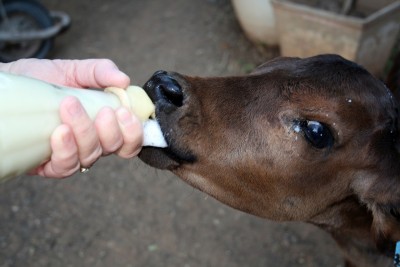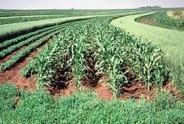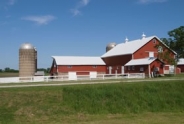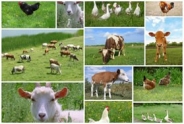Fertilizer Value of Milk and Feeding Milk
Alycia Drwencke, Dairy Management Specialist
Southwest New York Dairy, Livestock and Field Crops Program

With many farms being faced with the unfortunate situation of dumping their milk, some farms are considering the value of this milk for fertilizer and as feed for calves and cows. Below are two articles that discuss these opportunities to utilize milk rather than dumping it.
Attention Crop Farmers: Fertilizer Value of Milk by Karl Czymmek, Cornell PRO-DAIRY Specialist
Significant quantities of surplus milk from NY's dairy industry may have to be land applied in the coming weeks due to unprecedented market disruptions created by the COVID-19 emergency.
Milk has fertilizer value and crop farms may be able to take advantage of surplus milk for a portion of crop fertilization needs, especially if located near one or more dairies. Every 1,000 gallons of milk contains 44 lbs N, 18 lbs P2O5 and 17 lbs K2O. An economic value can be placed on these nutrients based on the following approximate fertilizer prices: Urea at $330.00/ton, DAP at $400.00/ton and Muriate of Potash at $380.00/ton. Using these values, the total N-P-K nutrient value of milk is $27/thousand gallons. A 5,000 gallon per acre application of straight milk delivers nearly $135/A of N-P-K that is readily available to plants. Milk also contains other nutrients such as sulfur, calcium, magnesium and zinc that have not been valued in this calculation. Further, there is some evidence that the land application of milk may significantly improve soil health by supporting bacteria and fungi that live in the soil.
Like many things, there are some other factors to be aware of. Milk that has been mixed with manure or that sits for very long in storage will be odorous, and if mixed with manure the resulting product will have a different nutrient content. Relatively short hauling distances will help make the most economically efficient use of the fertilizer value of surplus milk as transportation costs can quickly offset the value. Also, care should be taken to ensure that milk does not have offsite impacts from runoff. Injecting or incorporating milk into the soil soon after application will help to reduce odor and runoff risks.
Normally, land application of food processing waste, such as surplus milk coming from a processor, that is NOT done under a CAFO Permit requires a Part 360 registration from NYSDEC. Due to the COVID-19 emergency, DEC has issued a memo indicating that the agency will not be enforcing this requirement through October 1, 2020, as long as the land applications follow the technical guidance
in Provisional Guidance: Using Surplus Milk as Fertilizer Due to the COVID-19 Emergency. The guidance is also helpful for those land applications of surplus milk transferred directly from one farm to another that would not otherwise need a Part 360 registration.
The DEC letter and Ag and Markets guidance can be found at: tinyurl.com/milkasfertilizer.
Milk can be fed instead of dumped by Maggie Gilles, Associate Editor, Hoard's DairymanAs farms across the country are faced with the reality of dumping milk and reducing production, some are looking to their rations to absorb the extra pounds of production. In a University of Wisconsin fact sheet, Matt Akins and Liz Binversie outlined opportunities for incorporating excess milk into cow, heifer, and calf rations.
In lactating cow and heifer rations, milk can be included in a total mixed ration (TMR) at a rate of 10% to 15% of the ration mix. When fed this way, it behaves similarly to water reducing the dry matter content of the feed by about 5 percentage units. However, it also supplies fat, protein, lactose (sugar), and other nutrients that should be accounted for as much as possible. You can view the table below to reference the nutrient levels milk brings to a ration.

"At 15% of the ration (as fed), this would provide approximately 16 pounds of milk or 2 pounds of milk solids (dry matter) per cow," they wrote. "Milk inclusion should vary depending on the ration dry matter content with reduced inclusion in wetter rations."
To that end, TMRs dry matters should run at least 45% to 50%. For some perspective, if 100 cows were fed milk at 15% of ration as fed, 1,600 to 2,000 pounds of milk could be included.
A word of warning
Any time moisture is added to the ration, additional microbial growth is a concern. Monitor TMRs with milk in them for heating or odors. An acidic preservative can be added to limit this issue. Also, be aware of the potential for greater fly pressure.
Further, the feeding of unpasteurized milk puts the herd at risk for spreading Johne's disease, Mycoplasma, bovine leukosis, Staph. aureus mastitis, and other diseases. Obviously, pasteurization is preferred if possible, but high levels of inclusion may limit the ability to do so.
"Farms likely would need to dispose of a portion of milk via the manure lagoon or direct land application as it is likely not possible to feed all the milk each day," they explained.
Calves can consume it, too
While Akins and Binversie don't recommend feeding "dump milk" to dry cows or transition animals, calves can consume some of this milk. Even if farms are already feeding non-saleable milk to calves, that level can potentially be expanded some.
"Calves can consume up to 12 quarts of milk per day; however, intakes must be increased over a period of one to two weeks," the pair said. In addition to feeding up to that level, they suggested lengthening the weaning period to 12 weeks of age or even older. That will also allow farms a chance to improve grain consumption and engage a step-down weaning program.
Two important keys proposed by Akins and Binversie were paying close attention to managing bacterial loads in the milk and utilizing acidification with citric or propionic acid or preservatives such as potassium sorbate or sodium benzoate to limit their growth.
The University of Wisconsin has made their nutrient table available online, with additional resources. For more information on this topic, reach out to our dairy management specialist, Alycia Drwencke.
Upcoming Events
NY Small Farms Summit 2025: Stronger Together
December 5, 2025
Alfred, NY
We hope you will join us on December 5th for the 2025 New York Small Farms Summit! This is an opportunity to meet other farmers and ag supporters, learn about research and education projects, and set priorities for future efforts to grow small farm success.
At the Allegany County site, we will focus on giving trees a chance and how trees build resiliency on small farms. Whether attracted to fruit, nuts, vegetables, fodder or shade, trees can be an integral part of a successful farming system. Join us as we explore the opportunities for resiliency that come from adding tree crops or managing wooded areas of your farm for agroforestry or silvopasture systems.
Crops, Cows & Critters - Southwest New York Dairy, Livestock & Field Crops Newsletter Sponsorship
December 19, 2025
Our two forms of publications feature research-based and timely information from our four specialists, listed to the right, along with local event notifications and Cornell University outreach. This information is provided to participants who range from dairy, livestock, and field crops producers to agricultural suppliers and consultants.
Weekly Email Update: Shared with 625+ households who have signed up with our program.
Monthly Paper Mailer: To reach our stakeholders and farmers who lack internet access, we send out a monthly mailer where your company's logo and contact information would be featured with a mailing list of 330+ households.
If you sponsor our weekly and monthly publications you reach approximately 955 households.
Visit our website to view our newsletters!
Announcements
No announcements at this time.





